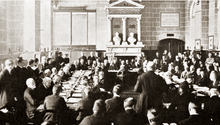Treaty of Saint-Germain-en-Laye (1919)
| Treaty of Peace between the Allied Powers and Austria | |
|---|---|

Signing ceremony, Austrian chancellor Renner addressing the delegates
|
|
| Signed | 10 September 1919 |
| Location | Château de Saint-Germain-en-Laye, Île-de-France, France |
| Effective | 16 July 1920 |
| Condition | Ratification by Austria and four Principal Allied Powers. |
| Signatories | |
| Depositary | French Government |
| Languages | French, English, Italian |
|
|
|
The Treaty of Saint-Germain-en-Laye was signed on 10 September 1919 by the victorious Allies of World War I on the one hand and by the Republic of German-Austria on the other. Like the Treaty of Trianon with Hungary and the Treaty of Versailles with Germany, it contained the Covenant of the League of Nations and as a result was not ratified by the United States but was followed by the US–Austrian Peace Treaty of 1921.
The treaty signing ceremony took place at the Château de Saint-Germain-en-Laye.
Already on 21 October 1918, 208 German-speaking delegates of the Austrian Imperial Council had convened in a "provisional national assembly of German-Austria " at the Lower Austrian Landtag. While the collapse of the Austro-Hungarian Army culminated at the Battle of Vittorio Veneto, the Social Democrat Karl Renner was elected German-Austrian State Chancellor on 30 October. In the course of the Aster Revolution on 31 October, the newly established Democratic Republic of Hungary under Minister President Mihály Károlyi declared the real union with Austria terminated.
With the Armistice of Villa Giusti on 3 November 1918, the fate of the Austro-Hungarian Monarchy was sealed. On 11 November 1918 Emperor Charles I of Austria officially declared to "relinquish every participation in the administration", one day later the provisional assembly declared German-Austria a democratic republic and part of the German Republic. However, on the territory of the Cisleithanian ("Austrian") half of the former empire, the newly established states of Czechoslovakia, Poland, and the Yugoslav Kingdom of Serbs, Croats and Slovenes (the "successor states") had been proclaimed. Moreover, South Tyrol and Trentino were occupied by Italian forces and Yugoslav troops entered the former Duchy of Carinthia, leading to violent fights.
...
Wikipedia
